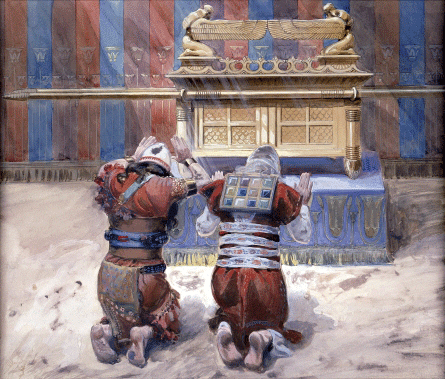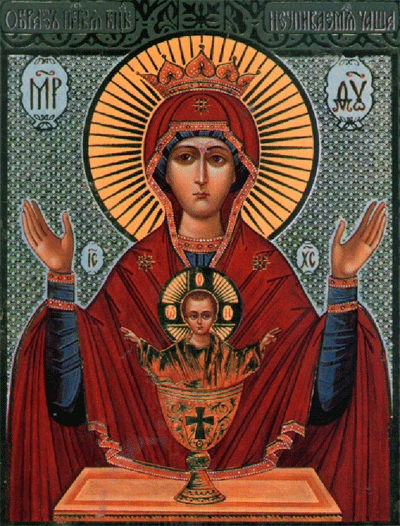

An ark may be either a place of refuge and security, like Noah's Ark, in which he and his family were saved from the deluge, or it may mean a strong case or chest for keeping something of great value. Such was the Ark of the Covenant, which contained the two tables of stone on which the Ten Commandments were written.
The Ark of the Covenant was of all the sacred things in the Old Law, the most sacred—the one most holy thing, that answered, though very imperfectly, to the Sacramental Presence of Our Lord which was to be in the Catholic Church. It was shrouded from human gaze and was the center of all devotion and worship in those olden times.
It had been made by Moses, according to special instructions from God, of the most precious wood, and overlaid within and without by pure and fine gold. It contained the most sacred memorials of what God had done for His people—the Tables of the Law, golden pots with the miraculous manna, and the rod of Aaron which had blossomed. Miracles attended it wherever it was carried. For instance, when the people were to enter the Holy Land crossing the Jordan, the priests bearing the Ark entered the stream, which then divided—the waters rolling away, until all the tribes had passed. When the first city of the land which God was to give to the Chosen People was to be taken, its walls fell miraculously down, after the Ark had been carried in procession round them.
The Ark being a symbol of holiness and perfection, by the pure wood of which it was made, the precious gold wherewith it was overlaid, and its sacred contents, is also a fitting symbol of the sanctity of Mary, who was to bear within Her the God of all holiness.
Again, the Ark is the pledge of the alliance between God and His people and thus the promise of the Virgin Mother of the Redeemer, who was to come of the House of David, is used by the prophet Isaias as an assurance to that house, that it was not to be extinguished by the hostile confederacy of the Kings of Israel and Damascus.
And thirdly, the Ark was the source of blessing and protection to all who housed or cared for it. So is Mary in the Catholic Church the protector and defender of the Christian people and of the Church. The Ark of the Covenant is therefore the chief material type of Mary in the Old Law, and thus it comes most fittingly to be used as a title in Our Lady's Litany.
A covenant is a solemn promise, an agreement between two parties. One binds himself by a promise if certain conditions are fulfilled by the other. We read of covenants that God made with His people in the Old Law. God needs no conditions and promises to remind Him to be good to us; it is only for our sakes that He makes covenants; it is as though He would do anything to induce us to trust in Him. He will keep his promises without binding Himself by any compact, but we poor, weak, sinful creatures need some assurance to make us trust anyone—even God. These covenants of the olden time were usually made after some sin of the people had been punished by God, in order that all fear and mistrust arising from the consciousness of guilt might be removed. After our First Parents were driven out of Paradise, a covenant was made with them, in the promise of the overthrow of the serpent by the Woman and Her Seed—in other words, the promise of the Redeemer, and the true Ark of the Covenant, Mary. After the Deluge, to remove any fear the survivors might have had that the world would be destroyed by another deluge, God made a covenant, promising that there would never be another destroying flood, and He gave them as a sign the rainbow, a token all could see to the end of the world, to ratify or seal His covenant. "I will set My bow in the clouds, and it shall be a sign of a covenant between Me and between the earth."
Then there was the covenant He made with Abraham. "In thee shall all the kindred of the earth be blessed. I will make of thee a great nation, and I will bless thee." (Gen. 12: 3)
There was also the covenant with the distrustful, murmuring Israelites in the desert, and lastly, the Great Covenant of Grace, the New Testament, sealed and signed with the Precious Blood of Our Lord, that all our sins would be forgiven through the merits of His death on the Cross.
Thus when we call Our Lady the Ark of the Covenant, we mean that She is the precious vessel which contained the Great Covenant between God and His creatures, Our Lord Himself. The great lesson we have to learn from this title is confidence in God and His promises. All His promises are contained, summed up, and verified in the great gift to us of His own Divine Son; and Our Lady, who contained within Herself "the Covenant," this most precious gift and pledge of God to man, is the true "Ark of the Covenant."

We may also think of Our Lady under this title as the Ark of Refuge for those in danger of shipwreck on the tossing sea of this world. Whatever our sins or follies may be, we must never lose trust in Our Blessed Mother Mary, the Ark of the Covenant, the sign and seal of God's mercies to us. She is as the beautiful rainbow set in the clouds of this life's troubles, to remind us of the fidelity of God and of His mercy in giving us Jesus.
Motto: "I am the Mother of holy hope. In Me is all hope of life and of virtue."
Practice: Trust in Mary.
One day St. Gertrude saw Our Blessed Lady with Her mantle extended. Under Her cloak flocked all kinds of wild beasts, lions, leopards, jackals, and the like, whom the Most Holy Virgin did not drive away, but gently caressed with Her hand, as though inviting them to take shelter with Her. The Saint understood by this figure the mercy of Mary towards sinners; She does not repel them, but receives them, and gently tries to win them back to Jesus; thus is She shown to be the true Ark of Refuge.
Contact us: smr@salvemariaregina.info
Visit also: www.marienfried.com